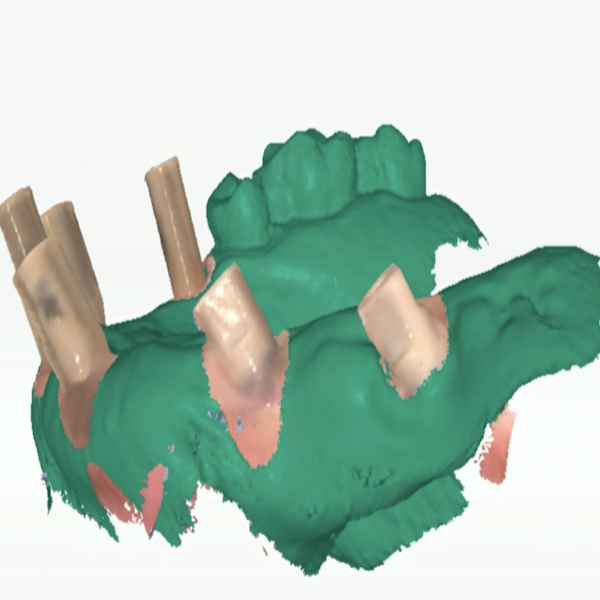Table of Contents
These days, digital implantology is becoming a trend worldwide. Compared with traditional implantology, digital implantology provides patients with a more comfortable and satisfactory experience in terms of safety, degree of trauma, treatment period, and visualization with standard and efficient processes. Today’s case, from Dr. Abdelrahman Khalaf and Dr. Kirollos Hany of the Faculty of Dentistry Assiut University in Egypt (Fig 1), was a case of maxillary edentulous all-on-six digital implantology for occlusion reconstruction.

Fig 1: Dr. Abdelrahman Khalaf and Dr. Kirollos Hany
Case Background
- Gender: Female
- Age: 61 years old
- Chief Complaint: Missing teeth in the upper jaw led to masticatory and esthetic problems, patients found it hard to adapt to the previous removable partial denture and asked for a treatment to solve these problems.
Make Treatment Plan
Two treatment plans were offered to the patient, either a removable complete denture or an implant-supported fixed prosthesis. After discussing the pros & cons of each option, the patient chose to go for implants with fixed prostheses.
The details of the treatment plan use the all-on-six digital implantology on #16, #14, #12, #22, #24, and #26 with the implant surgery guide. Used the Aoralscan 3 intraoral scanner to capture every detail of the intraoral information to reconstruct the occlusion with fixed restorations.
Design and Make a Surgical Guide

Fig 2: Designed the surgical guide in exocad, the implant site, depth, and angle were decided.
After the surgical guide was designed, the dentist used the AccuFab-D1s 3D printer to print the guide with resin SG01. AccuFab D1s is a 3D printer designed for dental use. With different kinds of resins, it can print models, surgical guides, temporary teeth, waxes and more.
Scan

Fig 3: Emergence profile formation after implantation. It was good and plump.

Fig 4: Scanned the implant scan bodies with Aoralscan 3 Intraoral scanner.
In this case, the dentist obtained the upper jaw with an Aoralscan 3 Intraoral scanner, removed the gingival data at implant sites, placed six scan bodies (all-on-six digital implantology), and then scanned again to capture detailed information. It was worth noting that #26 was full of a metal filling, Aoralscan 3 Intraoral scanner could obtain its morphology easily by activating the metal scan function without spraying.
Digital Smile Design(DSD) Design
In traditional treatment, it is hard to foresee the final tooth colour, shape and arrangement before the end of treatment and there is no opportunity for patients to express their opinions. Now, with the help of DSD technology, patients can fully participate in the design process, and share their opinions with the dentist to achieve “private customization” treatment and restorations.

Fig 5:In this case, the dentist determined the facial midline, dental midline, smile line and other parameters, designed the most suitable teeth with shape, length and width ratio, and finally completed the DSD design of maxillary implant long bridge #16~#24.
Temporary Teeth Fixed
The temporary resin bridge was tried on the model to check whether the occlusal, edge, adjacency and overall shape of the prosthesis could meet the requirements (Fig 6). If the temporary teeth are not suitable, they can be adjusted. Finally, the dentist placed the temporary teeth into the patient’s mouth without much adjustment (Fig 7).


Fig 6,7: The temporary teeth are put into the patient’s mouth
Comments from Dentists
Intraoral scanners simplify clinical procedures for us and allow better communication with the dental technician and with patients. Optical impressions reduce patient discomfort and are time efficient as they dramatically reduce the number of visits. Now we can deliver a full arch screw retained prosthesis in just 2 visits.
For us, the intraoral scanner is not just an impression tool but it also provides us with the final model on which we can make the final prosthesis thus eliminating plaster model errors which are very technique sensitive. In all-on-six digital implantology cases, thanks to the high accuracy of the intraoral scanner over conventional impressions, we can deliver these prostheses with very high satisfaction.
 ENG
ENG









